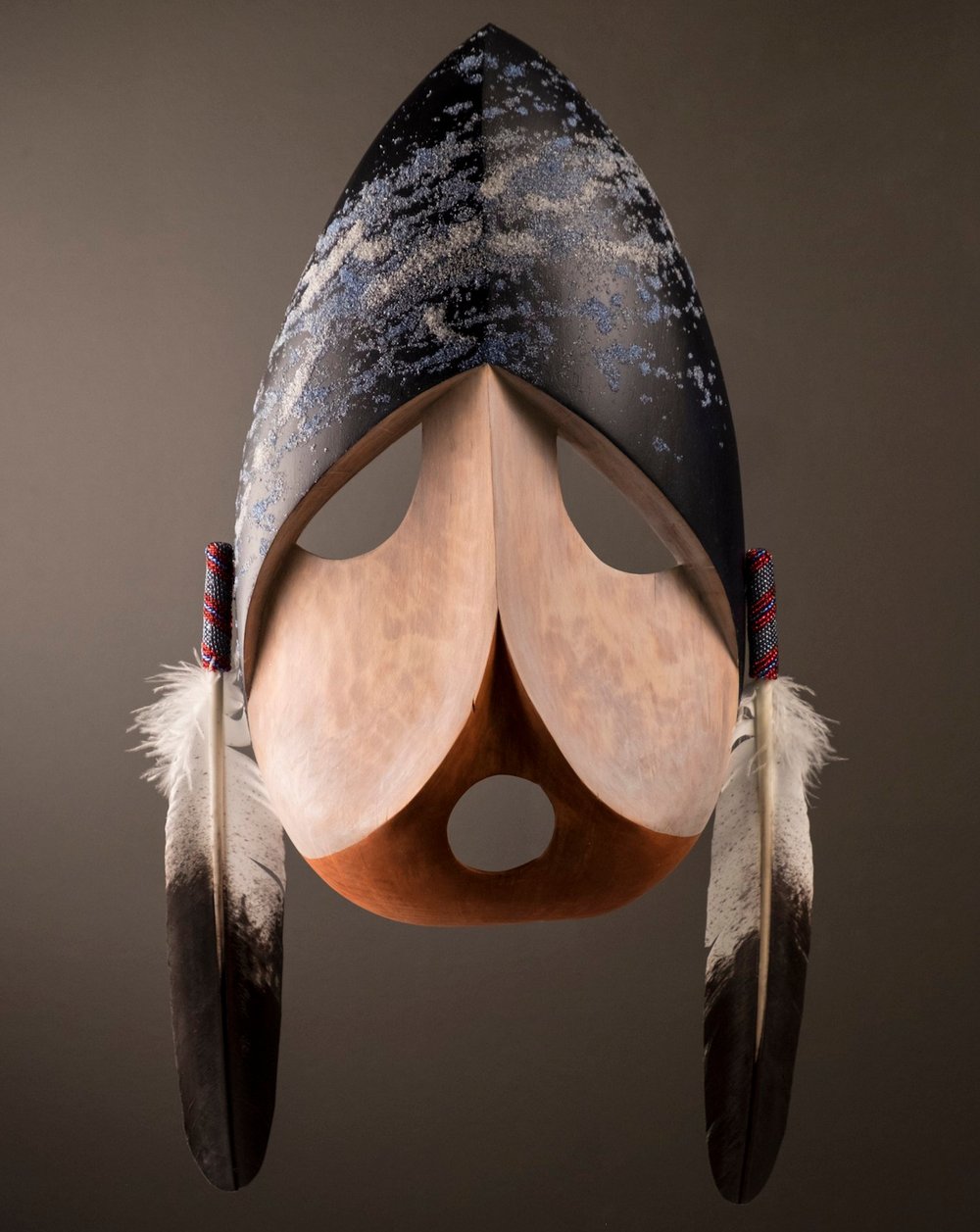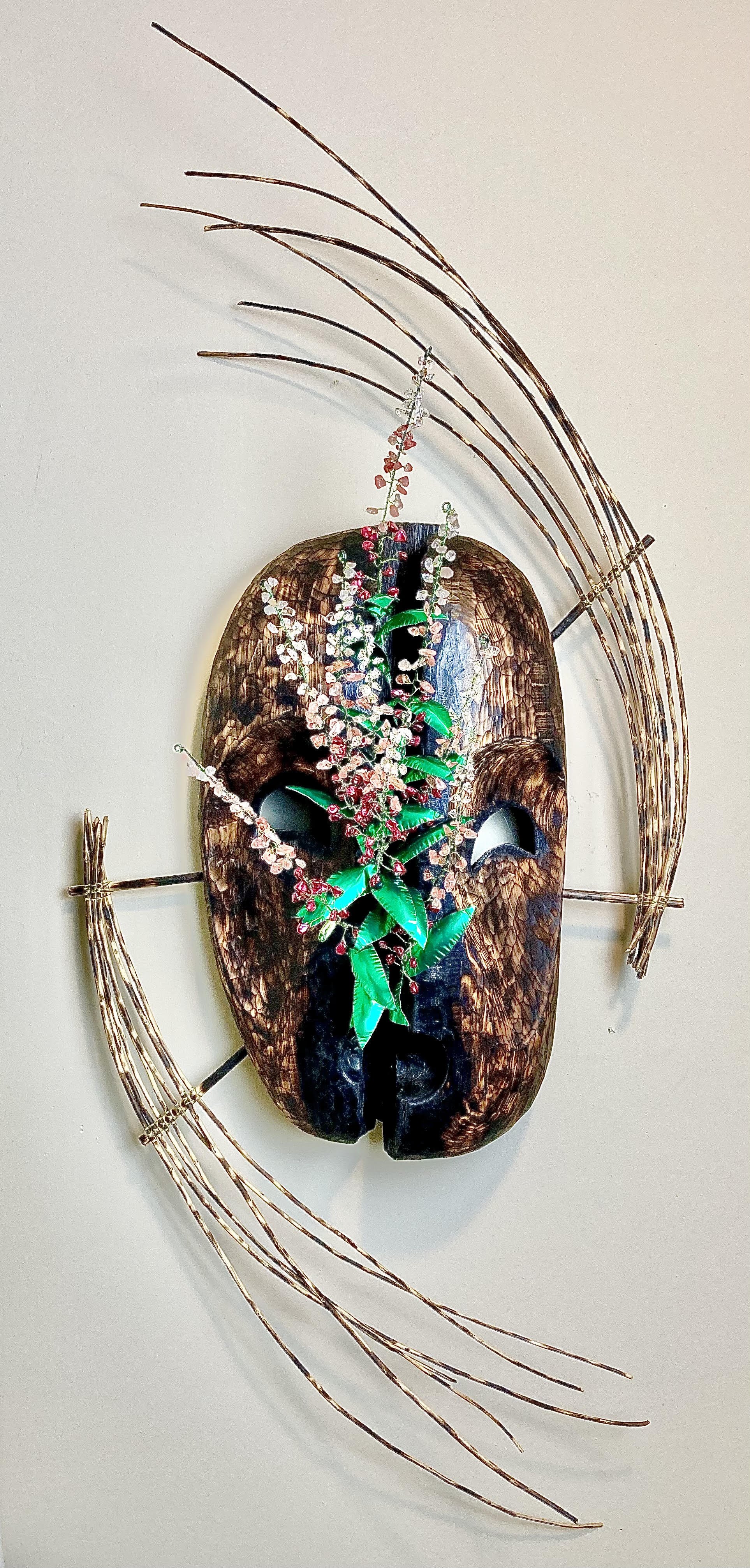Weapons of war; tools of renewal series
The goal of the Weapons of War; Tools of Renewal series is twofold. First is to represent the non-weapon methods that colonizers use to oppress other peoples, the mental, legal and emotional strategies used to try and break peoples down so they forget who they are. When I first conceived of this series, I had only intended to show these destructive methods. As I came closer to creating the first mask, though, I understood that it was critically important to also show the ways in which colonized peoples can rise again and remember who they are and where they come from. Therefore, the second goal is to uplift colonized communities and to hold a mirror to the ways they have survived, recovered, and are rebuilding their cultural communities on the memories held in their stories and their very bodies. These masks will all be paired, with a colonizer method mask connected with a mask representing a tool of resilience.
This series has been in the works for several years, and has been supported through the McMillen Artist Community Fellowship Grant I received in 2020. You can learn more about that grant and other MacMillen Foundation programming here: Robert B. McMillen Foundation.
Destruction
The first piece in the series is "Destruction," and is one of the simplest methods used by colonizers for thousands upon thousands of years. This concept came to me when I read an article about South American quipu (in Spanish) or khipu (in Quechua), which were sets of strings with a complex system of knots used to record all sorts of information, from inventories to genealogical histories. Although once common throughout South America, it took researchers a long time to decipher the sophistication of the system since the majority of them had been burned by the Spanish.
An important aspect of this mask, though it's burned and damaged, is that the yua, the inner spirit, is untouched. The yua represents our memories, as Indigenous people, that have survived in our minds and bodies, and which are in the process of reemerging.
SOLD (Bainbridge Island Museum of Art)
Basswood, charring, pigments, feathers, willow, beach-weathered bone.
16”w x 20.5”h x 2.5”d
First Growth
“First Growth” represents the renewal of an area after the destruction of a forest fire. Fireweed is among the first plants to emerge post-fire, along with ferns and mosses. It really is incredible to see fireweed in a charred landscape, with the vibrant pinks and greens against fire-blackened grasses and trees. It’s a reminder to acknowledge the destruction but to then remember what was there before and move toward rebuilding it, different than it once was but still beautiful.
An additional layer is that some seeds require the fire’s heat to germinate. The seeds were always there, laying dormant under the soil for many years, they just needed to be nudged awake.
NFS- undergoing a transformation
Yellow cedar, charring, stone beads, fresh pearl beads, wire, aluminum sheet, willow
19”w x 43”h x 10”d
his X mark
"his X mark" is based on how many of the treaties between Native American/American Indian Tribes and the US Government were signed by the chiefs who entered into these agreements on behalf of their people (see the second photo for an example). The chiefs had little to no understanding of English, written language, ownership of the land, or promises that were never intended to be kept. They were not unintelligent people, they were people whose hands were forced in ways too numerous to count.
SOLD (Bainbridge Island Museum of Art)
Alder, vintage ink, antique mother of pearl pens, vintage pen nibs, wire, metal letters
17”w x 19.5”h x 4.5”d
Humor/Laughter
The stereotype of the Indigenous people of what is known as the United States was popularized by early movies and TV shows. The way Native people were presented was always caricature - enlarged noses, red skin, a vocabulary consisting of “How” and war whoops. No matter the storyline, The Indian was one of several types: stoic, dangerous, lustful, or stupid, none of which were based in reality. Away from the screen, in real life community, there is one quality I have found Indigenous people to always possess: humor. Our gatherings are always full of joy and laughter, even when the purpose of the gathering is sad or upsetting. Even in the face of truly awful experiences, we find the slivers of humor scattered in the rubble. That joy has kept us together, has helped us build bonds between tribal communities that historically would never have met, and has helped us find the other side of pain and sorrow. It is beautiful, and it is necessary.
SOLD (Anchorage Museum, Anchorage, AK)
Old growth red cedar, pigments, beads, hat pins, willow
26”w x 28.5”h x 8.5”d




